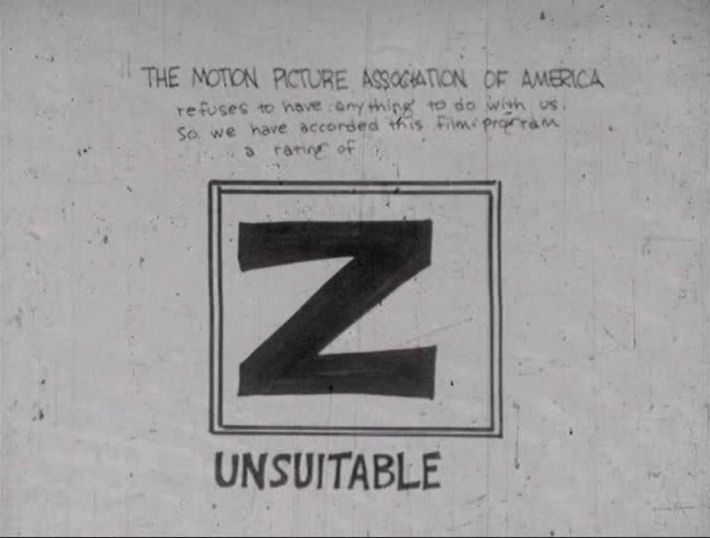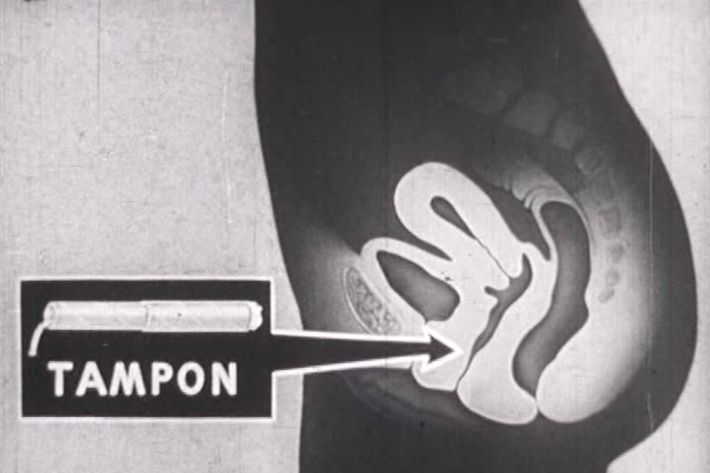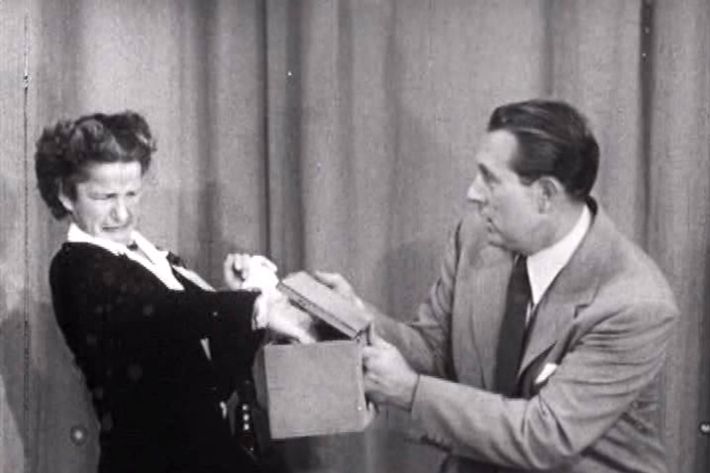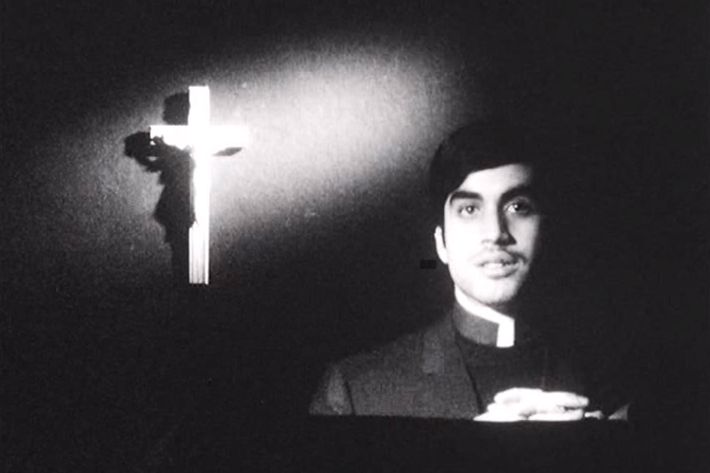
Before Gremlins, before fame, before everything, Joe Dante was a film student with a lot of motivation and time on his hands. For his senior thesis project at the Philadelphia College of Art, he and future producer Jon Davison assembled a seven-and-a-half-hour compilation of found footage: Saturday-morning cartoons and newsreels of A-bomb testing, butter commercials and B-movies, Western TV serials and educational filmstrips. The end result is not just an Everest of devotion to movies and TV, but a prophecy for the next half-century to come. In its rapid-fire collage of weird and wonderful detritus from America’s moving-picture past, his method presaged everything from Wonder Showzen to “RIP VINE” videos to Pee-wee’s Playhouse.
The Movie Orgy was an instant folk legend, but impossible to properly exhibit without incurring a tidal wave of lawsuits. As such, it’s been relegated to touring bootlegs (a 2016 showing at the Brooklyn Academy of Music was a capital-E Event), word-of-mouth, and the seedier corners of the internet. On the occasion of this film’s 50th anniversary, I set out to trawl the most dangerous back alleys of the Dark Web — so, this one web site where friendly cinephiles exchange downloads of hard-to-find-films and other rarities — for access to this lost treasure. I managed to find a relatively truncated version running a tight 330 minutes, and tromped into the heart of our pop-cultural darkness. What follows is this critic’s minute-by-minute report of an odyssey through media madness, and out the other side into nirvana:
00:01 — The film begins with a healthy dose of self-effacement. A hand-drawn faux-MPAA card appends a rating of “Z” for “UNSUITABLE” to what we’re about to see. An old-timey couple out at the moving-picture show jabbers to one another, “I paid to get in, and I’d like to see a good picture!” “We didn’t pay, we got in on a pass, for nothing, and this oughta be good.” “Yeah, it oughta be good — for nothing.” Let nobody mistake Joe Dante for having taken this all seriously.

00:21 — Why does everyone cutting a rug to “Walk Like a Man” on American Bandstand look so serious? You’re on TV, kids! At least try to look enthused! The core concept of young people tuning in to watch strangers dance on television seems odd, until one realizes that future generations will be completely baffled by homemade YouTube demo vids. Hard to tell if modernity’s getting weirder, or if it’s just as weird as it ever was.
00:48 — Time to get propagandistic! Ann-Margret pops up to deliver a breathy, ASMR-adjacent plug for American goods and discuss her recent tour through Vietnam, where we’re assured everything is going fine. Chipper atomic-test warnings and ads for collectible trading cards emblazoned with bomber aircrafts (packaged in your box of Shredded Wheat!) underscore the unsettling veneer of pep and gaudiness America has always used to clean up the military-industrial complex’s image.
01:06 — In a bloodcurdling sample from Western mainstay Andy Devine’s children’s program Andy’s Gang, the actor rasps out a rendition of “Jesus Loves Me” while accompanied by a taxidermic-looking cat and mouse on percussion. It’s far too early in the game for me to be hallucinating already.
01:23 — The animated instructional filmstrip on proper tampon use was as informative as it was unexpected. An early highlight!

01:35 — Dante’s great skill is juxtaposition; here, we get a delightful cut from Fu Manchu preparing to make an announcement to a sweaty Richard Nixon growling “sock it to me” on Laugh-In. Earlier, he spliced together vintage smut with reaction shots of eager children to create mini peeping toms. Take away the context, and you can make anything into anything else.
01:54 — Dante whips through upward of a dozen title cards, casting everyone from Bela Lugosi to Betty Boop in a colossally scaled ensemble piece that incinerates the walls between diegesis. A hypnotic rhythm develops in this repetitive cadence, a reminder that Dante exercises poetic license not just in his selection and arrangement of clips, but in their pacing.
02:20 — This is ideal viewing for the attention-deficit-ed among us, in that the film turns into something new every couple of minutes or so. Things getting slow? Blink a few times. This is the magic trick that makes a sprawling run time feel like it lasts for a fraction of itself.
02:31 — Dante traces a line from anti-Japanese sloganeering from WWII and its subsequent reinforcement through the filter of pop culture, as multiple characters across various works repeat the same slur in a reflection of the national ideology. The first thing they teach you in film school is that all art is political, especially the art that purports not to be, and Dante clearly took away the same lesson.
02:47 — It’s helpful to think of the film in terms of movements organized around a theme, and this one concentrates on the cloying, cutesy quality of kid actors. Dante was working in a pre–Cousin Oliver world, and yet he so clearly anticipated viewers starting to sour on the saccharine. My knees hurt. Hoping that stops of its own accord.
02:58 — Turns out Fear Factor, mid-’00s doomsayers’ favorite icon of societal decline, began as a talk-show bit decades earlier. For a cash prize, a woman reaches her gloved hand into a box full of “rats,” not knowing that the host is referring to ratted hair. Same as it ever was?

03:15 — While the whole film maintains a wry levity, it doesn’t seem to oscillate between genres. Sci-fi and horror definitely get the most playtime, but Dante plays variety-show host by breaking things up with the occasional earthquake set piece or, in this case, a cracking rendition of “Runaround Sue.”
03:33 — Shiny-faced Nixon is back, gravely accounting the details of his personal finances in archival footage of the infamous Checkers address. Impressive that, four years out from the Watergate scandal, Dante still recognized the camp, the desperation, and the ineffable off-putting-ness of our second-most-corrupt president. Also, I can begin to feel myself sinking into a pleasant state of lowered consciousness.
03:56 — As a building-sized grasshopper lays waste to a platoon of army men, I’m reminded of the much-feared “samizdat” from David Foster Wallace’s Infinite Jest, a film said to be so captivating that a person will watch it until they die of starvation. I could feasibly see myself watching Dante’s endless channel-flip forever. I would be okay with dying like this.

04:13 — “There’s no need to think of menstruation as a curse.” Words float through the film with nothing to latch onto; catchphrases can affect profundity, and mantras have their emptiness on full display. Four hours in, everything sounds like it’d be good on a T-shirt.
04:41 — The broken-record echo of an announcer chirping “in color!” gradually melts into nonsense syllables. The film works the phenomenon of semantic satiation on a larger scale, too, bombarding us with words and images until they’ve lost all meaning. It is in this respect that Dante’s work has a frightening modernism to it; his nonstop barrage sheds new light on the bleating senselessness of your given 24-hour news channel.
05:01 — Dante couples a shot of a dangling flying saucer crashing into the Capitol with a close-up of a toy car exploding on a Gila monster. He’s captivated by conspicuous fakery, by artifice, by — good lord, is it nighttime outside? When did that happen?
05:17 — Still plenty of time for a little sacrilege! To the strains of a crackly, reedy “Ave Maria,” we see a priest rapt in religious devotion as the tiny Jesus hanging upon the crucifix mounted behind him starts flailing around like a dying ant. The counterculture’s signature contempt for every pillar of the Establishment runs strong through Dante’s work. My memories of the world beyond this film have grown faint.

05:33 — I am exhausted and defeated, my brain feels like marmalade, and I could watch 100 more hours of this. For a viewer in 2018, what’s disarming is the familiarity of this sensation. The most prescient foresight of the film isn’t in the text it synthesized, but the reaction it yields. Dante’s great invention is the addictive drain of saturation, the feeling that sets in when you’ve been scrolling Instagram for two hours and realize that you’d have to muster more energy to stop than to continue. It’s the desire to break up your two-day binge-watch with a shower, and the desire to watch one more episode that invariably outmatches it. Partaking in The Movie Orgy feels good, but after a while, that pleasure turns into the narcotic sedation of morphine. Joe Dante’s only problem was that he did his job too well for our own good.

